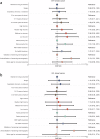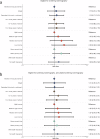Associations between social drivers of health and breast cancer stage at diagnosis among U.S. Black women
- PMID: 40770199
- PMCID: PMC12328792
- DOI: 10.1038/s41523-025-00804-0
Associations between social drivers of health and breast cancer stage at diagnosis among U.S. Black women
Abstract
U.S. Black women have disproportionately high breast cancer mortality, partly due to later-stage diagnoses. We examined how social drivers of health (SDOH) relate to stage at diagnosis by analyzing data from 4,995 breast cancer survivors in the Black Women's Health Study, Carolina Breast Cancer Study, and Women's Circle of Health Studies. SDOH were self-reported and stage was ascertained from medical records. We used polytomous logistic regression to estimate odds ratios (ORs) for diagnosis at stages III/IV or II versus stage I (referent), adjusting for age, insurance status, and income. Meta-analyzed results indicated that underutilization of screening mammography (OR = 3.21, 95% CI 1.90-5.43) and income below the federal poverty line (OR = 1.91, 95% CI 1.17-3.10) were significantly associated with later stage diagnosis (III/IV). ORs for lack of insurance and lower education were above 1.0, but not consistently statistically significant. These findings substantiate the importance of the affordability and utilization of breast cancer screening.
© 2025. The Author(s).
Conflict of interest statement
Competing interests: Author EVB served as member of Pfizer’s Advisory Board to enhance minority participation in clinical trials (7/2021-8/2023). All other authors declare no financial or non-financial competing interests.
Figures


Similar articles
-
Are Detailed, Patient-level Social Determinant of Health Factors Associated With Physical Function and Mental Health at Presentation Among New Patients With Orthopaedic Conditions?Clin Orthop Relat Res. 2023 May 1;481(5):912-921. doi: 10.1097/CORR.0000000000002446. Epub 2022 Oct 6. Clin Orthop Relat Res. 2023. PMID: 36201422 Free PMC article.
-
Mammography in combination with breast ultrasonography versus mammography for breast cancer screening in women at average risk.Cochrane Database Syst Rev. 2023 Mar 31;3(3):CD009632. doi: 10.1002/14651858.CD009632.pub3. Cochrane Database Syst Rev. 2023. PMID: 36999589 Free PMC article.
-
Maternal and neonatal outcomes of elective induction of labor.Evid Rep Technol Assess (Full Rep). 2009 Mar;(176):1-257. Evid Rep Technol Assess (Full Rep). 2009. PMID: 19408970 Free PMC article.
-
Prognostic factors for return to work in breast cancer survivors.Cochrane Database Syst Rev. 2025 May 7;5(5):CD015124. doi: 10.1002/14651858.CD015124.pub2. Cochrane Database Syst Rev. 2025. PMID: 40331515 Review.
-
Risk-reducing bilateral salpingo-oophorectomy in women with BRCA1 or BRCA2 mutations.Cochrane Database Syst Rev. 2018 Aug 24;8(8):CD012464. doi: 10.1002/14651858.CD012464.pub2. Cochrane Database Syst Rev. 2018. PMID: 30141832 Free PMC article.
References
Grants and funding
- U01 CA164974/NH/NIH HHS/United States
- P50 CA058223/NH/NIH HHS/United States
- HT94252310235/U.S. Department of Defense
- U01 CA164974/CA/NCI NIH HHS/United States
- RSG-23-1143513-01-CTPS/American Cancer Society
- P50 CA058223/CA/NCI NIH HHS/United States
- R01 CA185623/NH/NIH HHS/United States
- RSG-24-1321373-01-ESED/American Cancer Society
- R01 CA253450/CA/NCI NIH HHS/United States
- OG22873776/KOMEN/Susan G. Komen/United States
- T32 CA116339/NH/NIH HHS/United States
- R01 CA100598/NH/NIH HHS/United States
- R01 CA185623/CA/NCI NIH HHS/United States
- R01 CA100598/CA/NCI NIH HHS/United States
- T32 CA116339/CA/NCI NIH HHS/United States
- SAC220228/KOMEN/Susan G. Komen/United States
- ASP231042218/KOMEN/Susan G. Komen/United States
LinkOut - more resources
Full Text Sources

